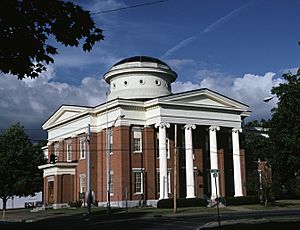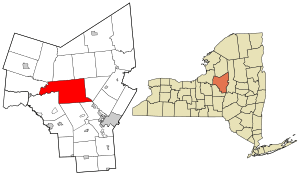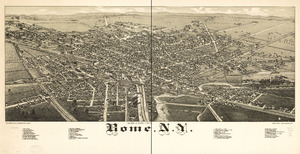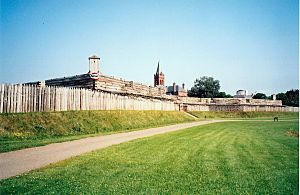Rome, New York facts for kids
Quick facts for kids
Rome, New York
|
|
|---|---|
|
City
|
|

Oneida County Courthouse
|
|
| Nickname(s):
The Copper City
|
|
| Motto(s):
Center of It All
|
|

Location within Oneida County and New York
|
|
| Country | United States |
| State | New York |
| County | Oneida |
| Incorporated | 1870 |
| Government | |
| • Type | Mayor-Council |
| Area | |
| • Total | 75.66 sq mi (195.95 km2) |
| • Land | 74.85 sq mi (193.87 km2) |
| • Water | 0.80 sq mi (2.08 km2) 0.99% |
| Elevation | 456 ft (139 m) |
| Population
(2020)
|
|
| • Total | 32,127 |
| • Density | 429.20/sq mi (165.71/km2) |
| Time zone | UTC−5 (Eastern (EST)) |
| • Summer (DST) | UTC−4 (EDT) |
| Area code(s) | 315 |
| FIPS code | 36-63418 |
| GNIS feature ID | 0962840 |
| Website | romenewyork.com |
Rome is a city in Oneida County, New York, United States. It is located in the central part of the state. In 2020, about 32,127 people lived there. Rome is one of the main cities in the Utica–Rome Metropolitan Statistical Area. This area is part of "Leatherstocking Country". This name comes from the famous books by James Fenimore Cooper, which are set in frontier times. Rome is also in New York's 22nd congressional district.
The city grew from an old Native American portage site. A portage is a place where people carry boats and goods overland between two waterways. Native American groups, like the Iroquois, used this important path. Later, Europeans also found this site very useful. It connected New York City and the Atlantic Ocean to the Great Lakes through the Mohawk and Hudson rivers.
Early European settlements grew around forts built in the 1750s. These forts protected the waterway. One important fort was the British Fort Stanwix, built in 1763. After the American Revolution, Rome started to grow more. This happened when the Rome Canal was built in 1796. This canal linked Wood Creek (which leads to Lake Ontario) and the Mohawk River. In the same year, the state created the Town of Rome. For a while, the small community near the canal was called Lynchville. This name came from Dominick Lynch, who owned the land.
The New York State Legislature officially made Rome a city on February 23, 1870. People in Rome often call it the City of American History.
Contents
History of Rome, New York
The Oneida Carrying Place
Rome was founded along an ancient Native American path. It was known as the Oneida Carrying Place. The Six Nations (also called the Haudenosaunee) called it Deo-Wain-Sta or The Great Carrying Place. This path was a portage road. It connected the Mohawk River in the east to Wood Creek in the west. The Mohawk River flows east to the Hudson River. Wood Creek flows into Oneida Lake and then to Lake Ontario.
This short path was the only overland part of a long water trade route. This route stretched over 1,000 miles. It connected Lake Ontario and the lower Hudson River. Travelers coming from the Hudson River had to move their goods and boats overland. This journey was between 1.7 and six miles long, depending on the season. Then they could continue west on Wood Creek to Oneida Lake. From there, the Oswego River led to Lake Ontario. This old trade route linked the Great Lakes and Canada to the Hudson River and the Atlantic Ocean.
During the French and Indian War, there was a lot of fighting in this area. This war was the North American part of the Seven Years' War. The British colonists built small forts to protect the Oneida Carrying Place. They wanted to protect the valuable fur trade from French attacks from Canada. However, French, Canadian, and Native American forces defeated a British force here. This was called the Battle of Fort Bull.
Later, in 1758, the British sent a large force to secure the Oneida Carry. They built a stronger fort complex called Fort Stanwix. After the war, the French gave their North American land east of the Mississippi River to the British. In 1768, the British signed the Treaty of Fort Stanwix with the Iroquois. They promised to keep lands west of the Appalachian Mountains for Native Americans. They also said American colonists could not settle there. But the British could not keep their promise. American colonists kept moving west, causing problems with Native tribes. The British left Fort Stanwix after the war. It fell apart, and settlers used its parts to build other structures.
Revolutionary War and Fort Stanwix
When the American Revolutionary War began, American forces took over the Fort Stanwix site. They rebuilt and improved the fort. The fort survived a siege by the British in 1777. It became known as "the fort that never surrendered". American soldiers and their Oneida Nation allies defended the fort. They were led by Colonel Peter Gansevoort. They successfully stopped a long siege in August 1777. British, German, and Native American troops attacked them.
This failed siege, along with battles at Oriskany, Bennington, and Saratoga, stopped a British plan. The British wanted to take control of the northern colonies. After this success, the Americans gained allies like France and the Netherlands. These countries became more confident that the Americans could win.
After the British were pushed back at Fort Stanwix, fierce fighting broke out. This happened along the American northern border and in the Mohawk Valley. Both American settlers and the Six Nations suffered heavy losses. Each side attacked the other. Many Oneida people fought with the Americans. Other Iroquois nations, like the Mohawk and Seneca, sided with the British. This meant Iroquois people were fighting each other.
The Americans used Fort Stanwix as a main base for attacks. They launched the Sullivan Expedition from here in 1779. This campaign destroyed villages of Iroquois nations allied with the British. General George Washington ordered this. It was in response to attacks in New York. One attack was the Cherry Valley Massacre. This was led by Mohawk Chief Joseph Brant. The Sullivan campaign destroyed nearly 50 Iroquois villages and their food. This caused many people to starve that winter. Many Iroquois went to Canada for safety.
American forces left the fort in 1781. After the war, settlers used materials from the fort to build homes. They built the Rome Canal along Wood Creek. This connected it to the Mohawk River. This allowed boats to travel from Lake Ontario to New York City.
After the Erie Canal was finished in 1825, Rome grew even more. The city became a center for industry and trade. The old fort site became just a mound of dirt. In the 1930s, the US government made Fort Stanwix a National Monument. This was because of its important history.
In 1973, the National Park Service began rebuilding Fort Stanwix. They used historical information to make it look like it did in the 1700s. It was finished in 1976. Today, the National Park Service runs the fort as a museum. In 2005, the Marinus Willet Center opened there. It has videos for visitors and stores historical items.
Commercial Growth: Erie Canal
The important east-west trade route was improved by building the Erie Canal. Construction on the canal started in Rome on July 4, 1817. The Erie Canal reaches its highest point in Rome, at 420 feet (128 meters) above sea level. The first part was finished in 1825. It connected the Hudson River to the Great Lakes by water. This led to more trade and travel. It helped communities along the route grow.
The Copper City
During the Industrial Revolution, Rome became known as the “Copper City.” Its metal factories made about 10 percent of all copper in the United States. In 1851, Jesse Williams started the first cheese factory in the United States in Rome. Williams also created the method used today for making large amounts of cheese. In the late 1800s, there were many dairy farms in the area. They sent their milk and cheese to customers in New York City.
The City of Rome officially became a city in 1870.
Revere Copper Products, Inc. was founded in Rome in 1928 and 1929. It is one of the oldest manufacturing companies in the United States. It was formed by combining several companies. At one time, 10 percent of all copper products used in the United States were made in Rome.
From Cold War to Today
Griffiss Air Force Base in Rome was open from 1942 to 1995. It closed as part of a military base reorganization. It is still home to Rome Laboratory, which is part of the Air Force Research Laboratory. It also houses the Eastern Air Defense Sector. Some of the former base land has been reused. Rome Free Academy, the city's public high school, moved there in 2002. The old airstrip is now part of Griffiss Airport.
Woodstock 1999 was held in Rome. It took place at the former Griffiss Air Force Base site. This three-day rock festival happened from July 23–25. About 200,000 people attended. Many famous bands played there. The festival ended with some problems.
During the September 11 attacks, the Eastern Air Defense Sector in Rome received the first report of a hijacking. This happened at 8:37 AM.
On July 16, 2024, a strong EF2 tornado hit Rome. It caused widespread power outages and damage to buildings. The tornado touched down north of the Erie Canal. It went through the center of Rome. It lifted up on the other side of Griffiss Air Force Base. A B-52 plane on display near the airport was moved almost 25 feet (7.6 meters). Two churches were badly damaged. They lost their steeples and their roofs collapsed. Many brick buildings fell down. The city, county, and state governments declared emergencies.
Geography of Rome
Rome is the second-largest city by area in New York State. It is the 140th largest city in the United States. The city covers about 75.7 square miles (196.1 km2). Most of this is land, and a small part is water.
Several main roads meet in downtown Rome. These include New York State Route 26, New York State Route 46, New York State Route 49, and New York State Route 69. New York State Route 365 also passes through the eastern part of the city.
Historic Places in Rome
Many places in Rome are listed on the National Register of Historic Places. This means they are important historical sites.
- First Methodist Episcopal Church of Rome
- Fort Stanwix
- Gansevoort-Bellamy Historic District
- Jervis Public Library
- Mills House
- Rome Arsenal
- Rome Elks Lodge No. 96
- Zion Church
Climate in Rome
Rome has a humid continental climate. This means it has four clear seasons. Winters are cold, and summers are mild. Summer high temperatures are usually between 70–82°F (21–28°C). Rome gets a lot of snow each winter, over 120 inches (305 cm) on average. This is because it is close to Lake Ontario, which causes "lake-effect snow".
| Climate data for Rome, New York, (1991–2020 normals, extremes 1961–present) | |||||||||||||
|---|---|---|---|---|---|---|---|---|---|---|---|---|---|
| Month | Jan | Feb | Mar | Apr | May | Jun | Jul | Aug | Sep | Oct | Nov | Dec | Year |
| Record high °F (°C) | 67 (19) |
72 (22) |
83 (28) |
91 (33) |
93 (34) |
97 (36) |
99 (37) |
96 (36) |
93 (34) |
85 (29) |
78 (26) |
71 (22) |
99 (37) |
| Mean daily maximum °F (°C) | 30.1 (−1.1) |
31.8 (−0.1) |
41.0 (5.0) |
54.9 (12.7) |
68.9 (20.5) |
76.2 (24.6) |
80.9 (27.2) |
79.3 (26.3) |
72.0 (22.2) |
58.9 (14.9) |
46.8 (8.2) |
35.7 (2.1) |
56.4 (13.6) |
| Daily mean °F (°C) | 21.5 (−5.8) |
22.5 (−5.3) |
31.7 (−0.2) |
44.5 (6.9) |
56.8 (13.8) |
65.3 (18.5) |
70.2 (21.2) |
68.7 (20.4) |
61.4 (16.3) |
49.7 (9.8) |
39.0 (3.9) |
28.3 (−2.1) |
46.6 (8.1) |
| Mean daily minimum °F (°C) | 12.9 (−10.6) |
13.2 (−10.4) |
22.5 (−5.3) |
34.1 (1.2) |
44.7 (7.1) |
54.5 (12.5) |
59.5 (15.3) |
58.1 (14.5) |
50.9 (10.5) |
40.5 (4.7) |
31.2 (−0.4) |
20.9 (−6.2) |
36.9 (2.7) |
| Record low °F (°C) | −31 (−35) |
−28 (−33) |
−16 (−27) |
5 (−15) |
24 (−4) |
32 (0) |
43 (6) |
35 (2) |
27 (−3) |
16 (−9) |
−4 (−20) |
−21 (−29) |
−31 (−35) |
| Average precipitation inches (mm) | 2.50 (64) |
2.37 (60) |
3.43 (87) |
3.72 (94) |
4.46 (113) |
4.20 (107) |
4.25 (108) |
3.60 (91) |
3.95 (100) |
4.67 (119) |
3.72 (94) |
2.95 (75) |
43.82 (1,113) |
| Average snowfall inches (cm) | 31.7 (81) |
23.4 (59) |
15.1 (38) |
3.4 (8.6) |
0.0 (0.0) |
0.0 (0.0) |
0.0 (0.0) |
0.0 (0.0) |
0.0 (0.0) |
0.1 (0.25) |
7.3 (19) |
20.8 (53) |
101.8 (259) |
| Average precipitation days (≥ 0.01 in) | 12.9 | 14.2 | 13.2 | 15.5 | 14.9 | 14.0 | 13.1 | 13.7 | 13.4 | 17.1 | 15.7 | 17.0 | 174.7 |
| Average snowy days (≥ 0.1 in) | 15.9 | 11.7 | 8.2 | 2.8 | 0.0 | 0.0 | 0.0 | 0.0 | 0.0 | 0.4 | 4.2 | 13.5 | 56.7 |
| Average relative humidity (%) | 66.0 | 66.2 | 65.0 | 64.1 | 63.3 | 66.8 | 66.0 | 68.2 | 72.7 | 69.8 | 72.3 | 72.3 | 67.9 |
| Percent possible sunshine | 42 | 46 | 52 | 58 | 64 | 66 | 65 | 60 | 54 | 48 | 43 | 40 | 53 |
| Source 1: NOAA (snowfall 1981–2010), Western Regional Center | |||||||||||||
| Source 2: Weatherbase | |||||||||||||
People of Rome
| Historical population | |||
|---|---|---|---|
| Census | Pop. | %± | |
| 1860 | 3,584 | — | |
| 1870 | 11,000 | 206.9% | |
| 1880 | 12,194 | 10.9% | |
| 1890 | 14,991 | 22.9% | |
| 1900 | 15,343 | 2.3% | |
| 1910 | 20,497 | 33.6% | |
| 1920 | 26,341 | 28.5% | |
| 1930 | 32,338 | 22.8% | |
| 1940 | 34,224 | 5.8% | |
| 1950 | 41,682 | 21.8% | |
| 1960 | 51,646 | 23.9% | |
| 1970 | 50,148 | −2.9% | |
| 1980 | 43,826 | −12.6% | |
| 1990 | 44,350 | 1.2% | |
| 2000 | 34,950 | −21.2% | |
| 2010 | 33,725 | −3.5% | |
| 2020 | 32,127 | −4.7% | |
| U.S. Decennial Census | |||
The city's population was highest in 1960. It then decreased because of changes in industries and job losses. Later, the closing of the Air Force base also led to fewer jobs and residents. The city has been working to create new types of businesses. Parts of the old base are now used for new purposes.
In 2000, there were 34,950 people living in Rome. About 28.1% of households had children under 18. Many people in Rome are Italian-American. They have a strong community in the "Little Italy" area.
Economy of Rome
Rome is home to AmeriCU Credit Union. This credit union serves people in Central and Northern New York.
Rome Memorial Hospital is another big employer in the city. Rome Hospital first opened in 1884. In 1940, it joined with Murphy Memorial Hospital. The new Rome Memorial Hospital has 129 beds.
Sports in Rome
The John F. Kennedy Civic Arena is a popular place in Rome. It hosts ice hockey and figure skating events. It also holds roller derby games. The arena was built in 1963–1964 and was updated in 2008.
From 1964 to 1988, the Rome Knights and later the Copper City Chiefs played ice hockey there. The Chiefs were a semi-professional team. They played against teams from Canada and other US states. The Chiefs were known for their tough style of play. They never had a losing season in 25 years.
The Rome Frenzy was a professional ice hockey team. They played in Rome starting in November 2010. However, they stopped playing in Rome in February 2011 due to low attendance.
Rome is also the main training spot for Hamilton College's rowing teams. Their boathouse was finished in 2022. It is located in Bellamy Harbor Park, next to the Erie Canal.
Education in Rome
Most of Rome is part of the Rome City School District. This district runs Rome Free Academy, the city's public high school. Other parts of Rome are in different school districts.
Rome Catholic School is a school for children from pre-kindergarten to 6th grade. It used to be a high school. In 2006, it started an early Cyber Security course for students. This was done with the Air Force and Syracuse University.
The New York State School for the Deaf is also located in Rome.
Transportation in Rome
Rome's main road connection is the Utica-Rome Expressway. This is a highway section of New York State Route 49. The expressway goes 14 miles (22.5 km) from Rome to Utica. In Utica, it connects to other major highways.
Rome has an Amtrak train station. The Empire Service trains stop here. These trains travel between Niagara Falls and New York City. The daily Maple Leaf train also stops here. It connects Toronto and New York.
Griffiss Air Force Base closed in 1995. It was turned into Griffiss International Airport. This airport is used for general aviation and military flights. There are no regular passenger flights from this airport.
CENTRO buses run six routes in Rome. Two of these routes serve the Amtrak station.
Famous People from Rome
See also
 In Spanish: Rome (Nueva York) para niños
In Spanish: Rome (Nueva York) para niños







